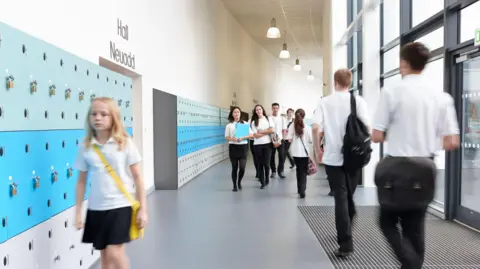Fears school attendance won't recover until 2034
 Getty Images
Getty ImagesSecondary school attendance rates could take a decade to recover to pre-pandemic levels, an Estyn report has found.
Data from 2023-2024 found while overall attendance for secondary schools had increased to 89%, pupils are missing on average of nearly 11 days of education more per year than they were before the Covid-19 pandemic.
Estyn warned that at the current rate of improvement, it would take more than 10 years for attendance rates to recover to pre-pandemic levels.
Ian Loynd, head teacher of St Teilo's Church in Wales High School, Cardiff, said chronic absenteeism is a "huge issue" which they were working hard to tackle.
Speaking to BBC Radio Wales Breakfast, Mr Loynd said he was confident attendance levels were "entirely a product of the pandemic, lockdown and closure of schools".
He described attendance as a "chronic" challenge for schools, with Year 7 children attending very well, while older children in Year 11 attend very poorly.
The report found Year 11 pupils sitting exams wanted to revise at home which contributed to the declining attendance rates.
While attendance is slightly up, Mr Loynd said whole school averages don't always tell the full story, as internal truancy is also a problem where children come to school but seek to be out of their lessons.
He put classroom avoidance down to a rise in emotional wellbeing difficulties among pupils, which he said were not an issue pre-pandemic.
Mr Loynd said pupils with poor attendance commonly have parents who themselves were poorly treated by education and the school have embarked on several positive initiatives to raise attendance, including charity support and supplying free school uniforms for disadvantaged families.
 Ian Loynd
Ian LoyndThere is a higher than average proportion of pupils on free school meals at the school, and Mr Loynd said he had visited pupils' homes to look at any mitigating factors which may be affecting their attendance.
He said for those financially struggling there is a great deal of shame, so he wouldn't expect families to come to them.
"I rarely meet parents who aren't aspirational for their children and there is a lot of shame around attendance," he said.
"We don't believe in an attendance strategy because one size doesn't fit all and blanket approaches rarely make a difference," he said.
Owen Evans, chief inspector of the report, said support remains "inconsistent" across Wales and schools cannot tackle the issue alone.
In a statement, Mr Evans said: "We've added new examples of successful approaches from schools and two further recommendations for Welsh government, reinforcing the pressing need for a joined-up, national approach to improving attendance."
The Welsh government said raising school attendance was a "key commitment" and the new and revised recommendations would be considered.
